
Hoka One One Stinson ATR 4
Stack Height: 37 mm (heel); 32 mm (toe)
Drop: 5 mm
Stated Features:
- Speedframe construction for midfoot capture and support
- Reinforced open mesh completes a durable, breathable package
- Molded Ortholite sockliner
- Updated with a wider platform and more accommodating fit
- Stable late stage Meta-Rocker
- The highest volume CMEVA midsole in the HOKA ONE ONE for maximum, lightweight cushioning
- 4 mm lugs provide all-terrain traction
- Podular outsole design provides stability on uneven terrain
MSRP: $160 USD
Size Tested: 10
Stated Weight: 336 g
Blister’s Measured Weight (size 10):
- Shoes + Laces: 308 & 331 g
- Stock Insoles: 25 & 26 g
- Total Weight: 333 & 357 g
Test Locations: Fort Collins, CO
Test Duration (So Far): 25 miles
Reviewer: 5’8”, 155 lbs (my running background and preferences)
Intro
Hoka One One built a name for themselves making shoes with thick, highly-cushioned midsoles. And while they now offer many options that are on the more moderate end of the spectrum, they still have several models that stick to their roots: high stack heights, lots of foam, and an emphasis on comfort.
The Stinson ATR 4 is the newest iteration of Hoka’s most highly cushioned trail shoe, designed to provide comfort for long runs — whether on the road or the trail. I’ve now put enough time in the Stinson ATR 4 to get an initial idea of how it feels, where it excels, where it feels less at home, and how it compares to a few of the other “maximalist” shoes on the market.
What Hoka says about the Stinson ATR 4
“Built on a new wider last, the STINSON ATR 4 has a much improved fit – appropriate to what you’re going to put it through. Namely, long, hard runs on whatever trails and roads you choose to explore. This versatile All Terrain performer features a wider flare in the forefoot and toe, which allied with the shoe’s cushion and durability, means you can go farther and longer. And with more lugs, more tightly packed, you can be surefooted whatever the conditions. Stinson 4 truly put the All Terrain in ATR. It’s aggressive-looking and aggressive doing, taking you far and wide in comfort.”
So Hoka is emphasizing the new Stinson ATR 4’s wider forefoot and toe box. They also specifically say that the Stinson ATR 4 is designed for “long, hard runs on whatever trails and roads you choose to explore.” So we have a pretty clear description of what the Stinson ATR 4 is supposed to do well, and, Hoka also says it’s supposed to do all this while remaining comfortable.
Based on my initial time in the Stinson ATR 4, I think most of Hoka’s description is pretty accurate, though a few things definitely require some caveats.
Fit
As always, we recommend trying on any shoe before buying it. But with that said, I can offer my thoughts on how the Stinson ATR 4 fits my foot (I’m reviewing it in my customary running-shoe size of 10). For reference, I have pretty average-volume feet, but I have large lateral splats which mean my midfoot widens when I am standing / running. I also have a fairly low instep. I prefer shoes with wider midfoot areas since that’s where I most commonly experience pain while running.
While the Stinson ATR 4’s toe box does feel pretty roomy, its midfoot and ankle area do not feel particularly high volume. Compared to the Hoka Speedgoat 2, the Stinson ATR 4 feels a touch wider in the toe box (near the end of the shoe) but the Stinson ATR 4 feels a bit tighter in the midfoot, and similarly snug in the ankle.
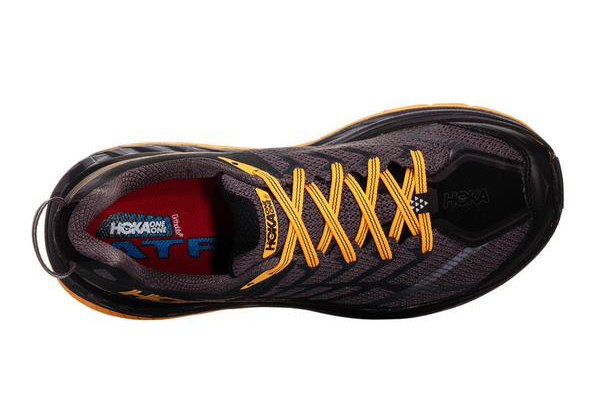
Compared to the Altra Olympus 3.0, the Stinson ATR 4 feels lower volume throughout, particularly in the midfoot and ankle.
So while the toe box of the Stinson ATR 4 is pretty roomy (my toes can splay out easily), the midfoot and ankle areas definitely aren’t what I’d call sloppy or particularly voluminous. I’ll talk more about how this fit affected on-trail performance, but the main takeaway from my initial time in the Stinson ATR 4 was that its fit actually felt pretty precise, and it felt noticeably more stable than the roomier Olympus 3.0.
Upper
The Stinson ATR 4 has a pretty thick, structured upper compared to shoes like the Speedgoat 2 and Altra Timp. The Stinson ATR 4 features a fairly thick mesh material throughout the whole upper, and then there are laminated sections over the sides of the foot, and thicker, sewn-on patches around the toe and heel.
Compared to the Altra Olympus 3.0, the Stinson ATR 4’s upper feels a bit thicker and and more rigid / structured. The Stinson ATR 4’s heel counter also feels a bit taller and stiffer than the Olympus 3.0’s heel.
The result of the Stinson ATR 4’s upper construction is a shoe that feels very supportive, but it’s not the most breathable shoe and its support doesn’t feel quite as uniform as shoes like the Salomon Sense Mantra that feature a sock-like liner. I haven’t yet experienced any specific hot spots or blisters, but if you know you like shoes with very airy and / or minimal uppers, I think you’ll find the Stinson ATR 4 to feel a bit bulky and overbuilt.
Midsole & Cushioning
The Stinson ATR 4’s gigantic compression-molded EVA midsole is definitely its defining feature. Hoka has long been known for their ultra-cushioned shoes, so the fact that the Stinson ATR 4 is the brand’s most highly-cushioned trail shoe is certainly saying something.
At 37 mm at the heel and 32 mm at the toe, the Stinson ATR 4 has a very high stack height. But as I noted review of the Altra Timp, stack height isn’t always a direct indicator of how a shoe will actually feel. And the Stinson ATR 4 is a great example.
While the Stinson ATR 4 literally towers over many running shoes, it isn’t some marshmallow. In fact the Stinson ATR 4 actually has a pretty stiff midsole — it is stiffer both longitudinally and laterally than the Hoka Speedgoat 2, Altra Timp, and Altra Olympus 3.0.
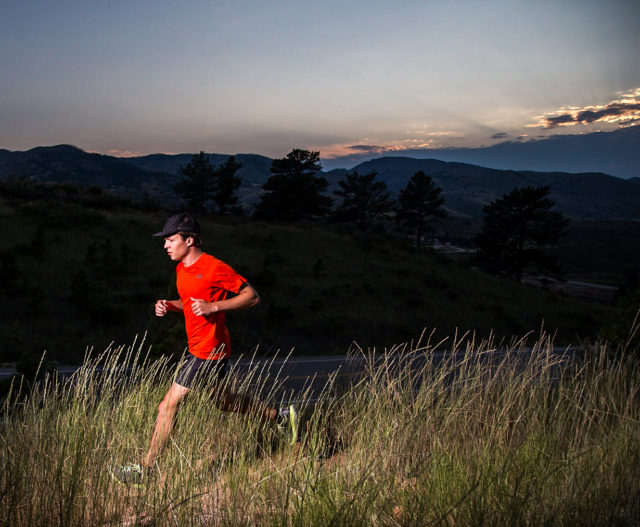
The Stinson ATR 4’s midsole also doesn’t feel very plush — you don’t “sink” into the shoe very much when landing, and the shoe doesn’t offer much rebound, either.
But while it may not offer the memory-foam-like ride of older Hoka shoes, or the springy feel of a shoe like the Altra Olympus 3.0, the Stinson ATR 4 still does what a maximalist shoe is supposed to do: mute out everything on the trail, and reduce foot fatigue.
The denser and stiffer midsole of the Stinson ATR 4 also makes it feel a bit more efficient than some of the more squishy shoes I’ve used, as I don’t feel like I’m losing a ton of energy every time I step down in the Stinson ATR 4.
The last thing I want to touch on here is the Stinson ATR 4’s stock insoles. While the Stinson ATR 4’s midsole is pretty stiff, its insole is pretty thick and squishy, which does provide some initial plushness while running. I personally found the Stinson ATR 4’s insole to be a bit too thick, especially since the shoe was already pretty tight around my midfoot. So I ended up swapping the Stinson ATR 4’s stock insoles for a much more minimal pair of insoles that I took from my old, first-generation Hoka Cliftons. After swapping, I was able to get a more comfortable ride from a fit perspective (I no longer had as much midfoot pain), but the Stinson ATR 4 then felt even stiffer and less plush as the insole no longer provided much squish. So the takeaway here is that if you tend to run with custom or aftermarket insoles, the Stinson ATR 4’s stiffer, less-plush midsole might become an even more noticeable factor.
Outsole & “Meta-Rocker”
The Stinson ATR 4 is designed for both roads and trails, and its outsole reflects that. The Stinson ATR 4’s outsole has less rubber than the sole on the trail-oriented Speedgoat 2, Olympus 3.0, and Timp, but much more rubber and larger lugs than the road-oriented Hoka Clifton 5 and Altra Duo.

The Stinson ATR 4’s rubber lugs aren’t as long or aggressive as those on the Speedgoat 2, which makes sense given that the Stinson ATR 4 is supposed to work pretty well on pavement, not just trails.
I’ve found the Stinson ATR 4’s traction to be pretty good for a crossover shoe — it doesn’t feel as grippy and secure as the Olympus 3.0 or Speedgoat 2 on really loose, wet, or deep surfaces (e.g., kitty litter gravel, deep mud, or deep sand). But on packed-down singletrack, shallower gravel / sand, and rocks, the Stinson ATR 4 offered plenty of traction. And when I needed to mix in a few miles on pavement, it feels a bit more efficient and stable than the Speedgoat 2.
Another important thing to note about the Stinson ATR 4 is the amount of “Meta-Rocker” it employs. Hoka adds what they call Meta-Rocker to many of their highly-cushioned shoes, and this basically means that the shoes’ toes and heel are carved away / start rising earlier than typical shoes (this concept is equivalent to the rocker used on skis, snowboards, surfboards, etc.).
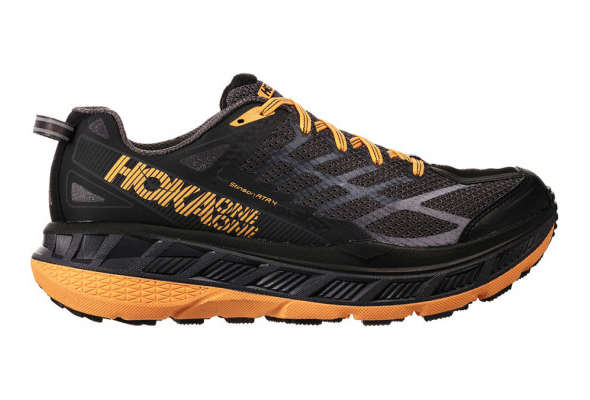
The reasoning behind this is that, with highly cushioned shoes, you can lose a bit of efficiency and energy when trying to push off on a super fat, flat sole. So by adding some rocker to the heel and toe, the shoe has a more rounded profile and therefore encourages the runner to “roll” through each stride, rather than having to use all their energy to push off a flat sole.
I’ve used several shoes from Hoka that feature some degree of their Meta-Rocker, and I think it’s pretty useful overall. On flat trails or roads, it definitely helps make highly cushioned shoes feel less bulky and slow. I’ll talk more about this further down, but I think the Meta-Rocker used on the Stinson ATR 4 makes sense for most situations, but holds it back in some specific scenarios.
Weight
The Stinson ATR 4 is not a very light shoe, but if you really want something that feels super light and sleek on your feet, you shouldn’t be looking at a shoe like the Stinson ATR 4 anyway. I’ve been running in highly cushioned shoes for years, so I don’t tend to notice the weight of bulkier shoes while running. But if you’re coming from more minimal shoes, it will probably take some time to get used to the heft of the Stinson ATR 4.
For reference, here are a few of our measured weights (per shoe, in grams) for some relevant shoes.
297 & 297 Hoka One One Speedgoat 2, size 10
335 & 337 Altra Timp, size 10
333 & 348 Altra Olympus 3.0, size 10
333 & 357 Hoka One One Stinson ATR 4, size 10
On the Trail
As I alluded to earlier, the Stinson ATR 4 accomplishes the goal of shoes that have this thick of a midsole — it steamrolls over all sorts of rocks and roots on the trail, and does so without transmitting much feeling at all back to my foot. The Stinson ATR 4 probably offers the least amount of ground feel of any running shoe I’ve used.
And while the Altra Olympus 3.0 does a similarly good job of muting out stuff on the trail, the Stinson ATR 4 feels distinctly different than the Olympus 3.0. This is due to several factors, but I think the main thing is the stiffness of the Stinson ATR 4’s midsole. The Olympus 3.0 feels surprisingly energetic and springy, while the Stinson ATR 4 just feels kind of dead. And that’s not necessarily a bad thing, since, if I were to guess, I’d say the Stinson ATR 4 is probably more efficient than the Olympus 3.0 in terms of how much energy you lose in each step.
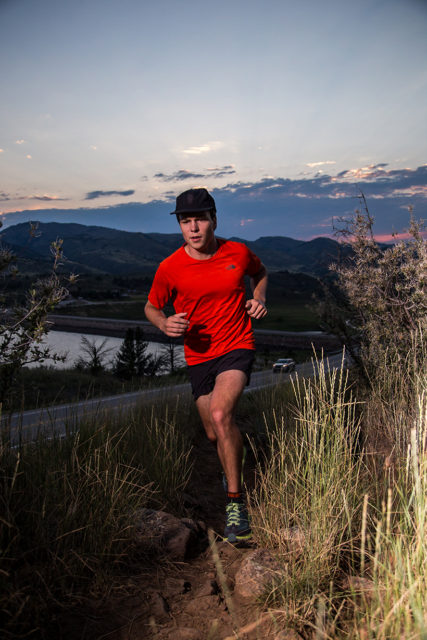
I personally prefer a springier ride in my maximalist shoes since, even if you do lose a bit by being able to sink into the shoe, I’ve found that the rebound makes the shoes feel less sluggish. The Stinson ATR 4 provides a less dynamic ride, and it just feels like a bigger, bulkier shoe than the Olympus 3.0, despite the two shoes sharing nearly identical stack heights.
But while the Stinson ATR 4’s midsole doesn’t provide much energy, I did find that its tighter fit through the ankle and midfoot provided surprisingly good stability for how high its stack height is. I really like the Olympus 3.0’s more generous fit on mellower trails, but on really rocky trails with lots of off-camber terrain, the Stinson ATR 4 felt noticeably more secure than the Olympus 3.0. The downside to this — for my foot at least — was that I’ve experienced a good deal of midfoot pain in the Stinson ATR 4. People with more average- or narrow-width feet might not have this issue, but it was definitely noticeable for me.
The last noteworthy aspect of the Stinson ATR 4’s on-trail performance is its rockered sole. The Stinson ATR 4’s sole starts bending upward right around the widest point in the forefoot, and rises a couple inches from the back of the heel. This gives the Stinson ATR 4 a pretty rounded profile, which I really like on flatter trails. The rocker helps the shoe roll through each stride, and encourages me to keep running, even when I don’t really feel like it. Kinda like a personal trainer for your feet.
But for a shoe that’s supposed to work “on whatever trails and roads you choose to explore,” the Stinson ATR 4 has a bit more rocker than I’d like. I’ve found that, on steep downhill sections of trail, the Stinson ATR 4 feels like it’s getting away from me, and I’m left wishing for a flatter heel so that I could engage the braking lugs a bit easier. This is really only an issue on steep sections (I’d give a very rough estimate of around 30°+). But I definitely feel more comfortable running down this sort of terrain in the Speedgoat 2 (which has larger lugs and a flatter heel) and the Olympus 3.0 (which has a flatter profile overall).
But given that the Stinson ATR 4 is also supposed to work equally well on pavement, I don’t think I can really be all that upset that it doesn’t perform as well as dedicated trail shoes on technical trails. If you use the Stinson ATR 4 for what it’s designed for — roads and mellow trails — then its rocker will likely be much more of a benefit, rather than something that holds it back.
Durability
I’ve only put about 25 miles in the Stinson ATR 4 so far, and I have no bad news to report. I’ll update this review as I get more time in the shoe to identify any potential durability issues.
Who’s It For?
Like any shoe with this thick of a midsole, I would not recommend the Stinson ATR 4 to anyone who loves shoes that offer a lot of ground feel, that feel very light, or that excel on technical trails.
But for people who know that they want a lot of cushioning and are looking for a shoe that will work both on roads and trails, the Stinson ATR 4 is a strong competitor. This is especially true for people who dislike the really spongy, mushy feel of some other maximalist shoes, but who still want the steamrolling capabilities of a shoe with a thick midsole. The Stinson ATR 4’s rocker doesn’t make it ideal for really steep trails, but its supportive upper and moderately aggressive outsole design make it feel very comfortable on slightly mellower trails and roads.
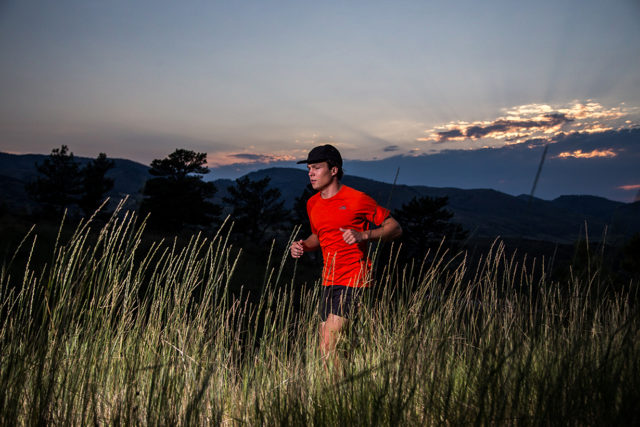
And the last thing I’d note is that, due to its thick midsole, rockered design, and supportive upper, I think the Stinson ATR 4 could make for a really nice fastpacking or hiking shoe.
Bottom Line
The Hoka One One Stinson ATR 4 offers a blend of cushioning and rigidity that results in a unique running experience. It rolls over rough trails with ease, transmitting little-to-no feedback from sharp rocks, bumpy roots, or other potentially painful objects. But unlike some other similarly cushioned shoes, the Stinson ATR 4 does not feel very spongy or springy — instead, it feels fairly rigid, and consequently, pretty efficient for how big it is. Its rockered sole doesn’t make it ideal for really steep, technical trails, and it’s obviously not the lightest or quickest shoe on the market. But if you spend your time pounding both pavement and singletrack, the Stinson ATR 4 is a highly cushioned shoe that feels pretty efficient for its size, offers good traction on many surfaces, and feels more stable than some of the competition.

The Stinson ATR 4’s high stack height is terrible for use as a trail running shoe. Its high stack height is hazardous! The shoe is laterally unstable with a strong tendency to roll inward or outward, such unexpectant occurrences are a painful nuisance putting the user at risk of a sprained or broken ankle.
Having owned both the Stinson ATR and Speed Instinct, I find the lower (for a Hoka) stack height of the Speed Instinct 2 much more suitable for trail running. Speed Instinct fits more like the Stinson ATR, i.e., narrow enough at the heal, instep and midfoot to keep toes from banging into the generous front of the shoe on downhill runs. Still not quite as nice of a toe box shape to allow for toe splay as the ATR 4. By comparison, all Altra running shoes are much too voluminous for my foot.
Hi Marc,
There is definitely an inherent tradeoff you have to take into account when it comes to shoes with higher stack heights. Shoes with thinner midsoles will almost always feel more secure, particularly on off-camber terrain and on technical trails. But in the review I wanted to emphasize that the Stinson ATR 4 feels a bit more stable *than shoes with similar stack heights* (i.e., for how high off the ground it is, the Stinson ATR 4 feels fairly stable). I haven’t rolled my ankle in the Stinson ATR 4 any more than I have in similarly cushioned shoes, but I also spend much of my time in shoes that have stack heights in the 27-33mm range, so I’m accustomed to the loss in lateral stability (vs. less-cushioned shoes).
So I’m definitely not trying to convince anyone that the Stinson ATR 4 is a perfect shoe for really gnarly trails (which I attempted to make clear in the review), or that it offers the same stability of shoes with thinner midsoles. But compared to other similarly cushioned shoes, the Stinson ATR 4 feels pretty stable.
The Stinson ATR 4 isn’t a dedicated trail shoe — it’s meant to work both on trails and on roads. And in that context, I think it does pretty well. On pavement, or trails that are pretty consistently flat, I think it performs well for how cushioned it is.
So no, the Stinson ATR 4 isn’t the ideal shoe for technical trails. But for a shoe that you’ll be using on both the road and mellower trails, I definitely wouldn’t call it “terrible.”
Hope that provides some clarification.
– Luke
I have a trail cut though my land in ky. Pastures that have been farmed so each step is slightly questionable. A VERY rugged gravel road & just packed grass. My atr 4 struggles some as my speedgpat 2. Is the hiking boot that review’s just for hiking an option for running???
If the Mafate is too much and the Clifton not enough try the Stinson. I like to race in Cliftons and train in Mafates but if a Mafate is too heavy the Stinson will work. With Hoka it is all about the fit and the cushioning.